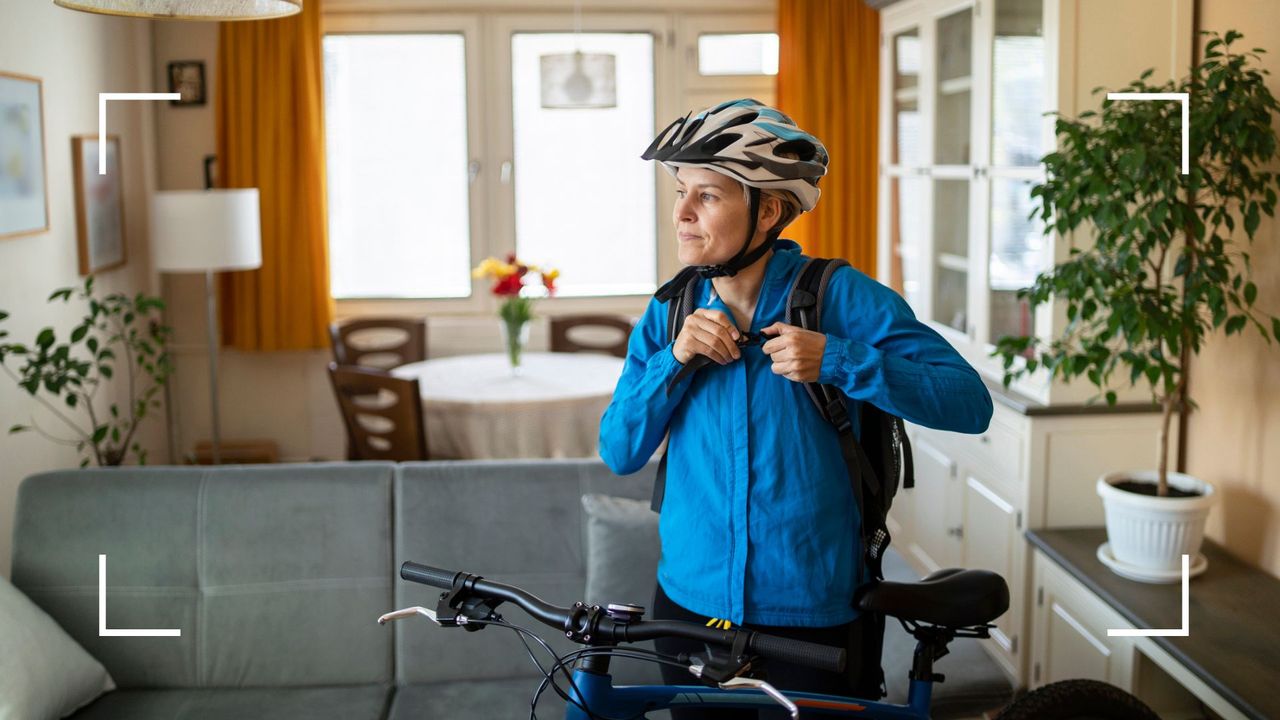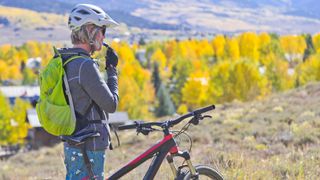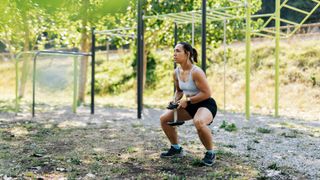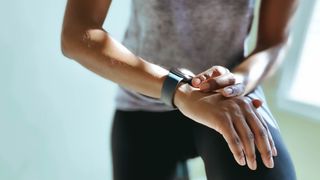How to do cycling as a workout for beginners: 8 tips for getting started with sessions to try
Doing cycling as a workout is a low-impact way to improve your fitness. Here, two specialists explain how to incorporate the activity with 2 workouts to try for yourself


Jess Bacon
Doing cycling as a workout is a little more intense than just going for a ride, but if you're looking to improve your health, get in shape, and reap the benefits of low-impact exercise regardless of your fitness level, it could be the activity for you.
What's more, cycling is one of the most versatile sports out there. While many people think they need to invest in expensive bikes and gear to enjoy cycling, that's far from the case. Riding outside is a great way to enjoy the fresh air but you can do many of the same activities and reap the same benefits by simply heading to your local gym and jumping on the stationary bike a couple of times a week.
"Compared to running or even walking, cycling gives support while still allowing you to be weight-bearing," says personal trainer Alanah Bray. "This also means that it’s kind on the body and it’s low-impact on joints, which makes it a repeatable exercise as the body doesn’t need time to recover. You can also improve your aerobic endurance as well as burn calories through cycling."
Here, to explain how to do cycling as a workout, woman&home speaks to Bray, a former Olympian, and a strength and conditioning instructor to reveal all you need to know. So whether you're looking to do spinning for weight loss or just want to improve your cardiovascular fitness, we've got you covered with tips and two different beginner workouts to try.
How to do cycling as a workout
1. Start steady
Before you jump on the bike, spend some time getting your muscles ready for exercise. Not only will this help make your ride a little easier as your body will be prepared for the hard work but there will be less chance of muscle soreness and injury afterward.
"As a warm-up, I would start with a pulse raiser of 5 - 10 minutes of cycling at a moderate intensity, followed by a series of mobility exercises," says physical performance coach and strength specialist Elizabeth Butler-Clack.
Then, much like doing swimming as a workout, it's important to take cycling at your own pace to begin with. If you're thinking about riding outdoors with friends, head out with just one person or solo to begin with and build up your fitness, so you don't feel pressured to keep up a pace you're not comfortable with. If you're in the studio, don't feel pressured to move up a level if you're not ready yet.
Sign up for the woman&home newsletter
Sign up to our free daily email for the latest royal and entertainment news, interesting opinion, expert advice on styling and beauty trends, and no-nonsense guides to the health and wellness questions you want answered.
Over time, work on increasing your intensity and how long you can cycle for, adapting your workouts, and increasing your time on the bike to suit your level of fitness.

2. Find a program that works for you
Once you're in the swing of things, finding a routine could help you stay motivated and keep progressing. Your workout could be as simple as cycling three times a week for 30 minutes, for instance, or a rhythm-based ride in a spin class once a week, whatever works best for you.
For beginners, silver medallist Olympian cyclist Dotsie Bausch recommends doing some kind of interval training regularly to improve fitness. "I love power intervals as they're somewhat short on time but very effective for generating fat loss and cardiovascular training," she says.
Here, Bausch recommends her favorite beginner's program to get started with cycling as a workout:
- Warm-up: "For at least 15 minutes, building pressure on the pedals steadily."
- Intervals: "Then you will do 8 x 2-minute intervals, which is 2 minutes as hard as you can go with 2 minutes rest in between very easy pedaling, 8 times," she suggests.
- Progression: "If you're a beginner, you can start with 5 or 6 intervals and build up to 8," she says. "It's a really fun (and hard) workout and but if you have a heart rate monitor or a bike with a power meter, you can try and beat yourself each time you do it."
If you're looking for variation in your session and want to focus on building up your fitness slowly, try Butler-Clack's favorite pyramid workout for beginners:
- Warm-up: Easy cardio exercise on the bike with mobility stretches.
- Main session: "The set will consist of 1-minute at a moderate/high intensity followed by a 1-minute recovery cycling at a low intensity, 2 minutes at a moderate/high intensity followed by 2 minutes of recovery at a low intensity, 3 minutes at a moderate/high intensity followed by 3 minutes recovery at a low intensity," says Butler-Clack, who works with online platform P3rform. "Then 2 minutes at a moderate/high intensity followed by 2 minutes of recovery at a low intensity and then1-minute at a moderate/high intensity followed by a 1-minute recovery cycling at a low intensity."
- Cool-down: "I would recommend 5-10 minutes gradually reducing intensity from the main session to help the body gradually return to its normal state."
3. Cycle across different elevation
For those cycling outdoors, moving across different elevations will really help to push your fitness levels up. It's much harder than cycling across level terrain admittedly, but so worth it.
"If there are only one or two hills in your area, you can always freecycle back down as your recovery and turn round to repeat the hill charge," says fitness trainer and cycling specialist Gabriella Guevara. "This routine will send your heart rate sky high and you can swap between a seated and standing position on the incline to really push yourself. For those new to the activity, investing in an e-bike might be best as it will give you an extra push and surge in confidence to make it to the top."
4. Practice good technique
Much like with running, everyone thinks they can just jump on a ride and ride but that's not the case, says the trainer. "Practising good technique can help with riding efficiency and reduce the risk of injury," she says.
Simply put, your back should be relaxed with your torso leaning forward slightly, and there should be a relatively straight line held between your hips and shoulders.

5. Incorporate some strength training
While there are so many benefits of cycling, particularly for women over 40, it is important to mix up your routine with strength training. Whether you do Pilates for strength training or classic weightlifting, incorporating resistance training in will help you develop your muscles to keep up with cycling and improve your form.
"If building strength is also one of your aims, it is important to include some strength training sessions in your training week," confirms Butler-Clark.
Plus, as cycling is mainly a lower-body workout, doing some upper-body work will help you 'tone', i.e. build muscle, in your arms, back, shoulders, and chest too.
6. Include some fun cycling workouts into your routine
Cycling for hours on end every week without spicing things up once in a while is bound to get boring and, as the research shows, we are much less likely to continue with an activity when it becomes dull.
For a fun indoor cycling workout, opt for a rhythm-based ride. If you cycle indoors, this will be your standard spinning class. “Rhythm-based rides hardly have any metrics. For inexperienced riders or beginners, this is really enticing because it isn't numerically competitive," explains Guevara, who is also the founder of The Cadence Club. Listening to your favorite songs is the best workout motivation, but it's also an opportunity to discover new music and allow the beat to “help move your body”.
7. Consistency is key
Perhaps the most important tip the trainers have for those looking to do cycling as a workout is to keep it up. It can be hard to get up on cozy mornings or fit a workout in around your schedule but if you're looking to make changes, you need to cycle every week.
"When it comes to building aerobic fitness, consistency is key," says Butler-Clark. "Try to ride regularly even if it's just a low-intensity recovery ride. Over time, this will help build your aerobic fitness."
The good news is, cycling is a low-impact sport so the recovery time between sessions is less than it would be for running for weight loss, for instance. "Cycling little and often may be the best approach," says Bray, who works with Fit Again. "This will allow it to become more of a habit than a chore."
8. Listen to your body
Try not to push yourself too hard in the beginning, says Butler-Clack. "Try to gradually increase your mileage over time, as this will help build a base of aerobic fitness and reduce the risk of injury."
As well as this, contrary to popular belief, it's important to take time off from exercise. It's on the days you don't spend cycling as a workout that you'll achieve most of your progress. During this time, your body gets a much-needed break from the physical stress of working out, allowing your performance to improve, your muscles to build back stronger, and reducing the risk of injury, as the trainer says.

Is cycling a good exercise for women over 40?
Yes, is a great workout for women - and particularly those over 40. As Donna McConnell, who did her first triathlon at 46, says, cycling can help to manage many symptoms of perimenopause - like hormonal fluctuations and the weight gain associated with it - as well as being a new way to meet friends and find a like-minded community.
However, on reaching this age, it's really important to continue with other forms of exercise alongside cycling. As the American Academy of Orthopaedic Surgeons explains, our bones continually refresh themselves up until about the age of 40 and while cycling has many benefits as a low-impact exercise, it doesn't help to maintain bone mass in the same way that running or walking as a workout does. A lack of bone mass means lower bone density and a higher risk of fractures later in life.
How long should I bike for a good workout?
If you want to burn calories then doing cycling as a workout for between 30 and 60 minutes is more than enough, says Bausch, who is also an ambassador for Running On Plants. "Steady, moderate cycling burns about 300 calories in 60 minutes, but you can burn more than that if you increase the intensity," she explains. "According to the Harvard health letter, a 155-pound person can burn as many as 298 calories in a 30-minute bike ride if they pedal at a 12 to 14-mile-per-hour pace."
With this though, it's important to remember that there are many factors that go into how quickly someone will lose weight. "For example, diet, the intensity of exercise, and genetics," says Butler-Clack. "To maximize fat loss and aerobic fitness gains, it's important to combine cycling with a healthy, balanced diet."
Is outdoor cycling better than indoor?
It's entirely down to personal preference. For example, if you live in a busy city with limited bike routes, you may find cycling outdoors a stressful, slow, and possibly dangerous experience so indoor cycling may be better suited for you. Yet if you live in the countryside, away from traffic, outdoor cycling may be able to offer all the benefits of fresh air and green surroundings without an issue.
Ultimately though, research on this is very limited. The largest study on the subject from the University of British Columbia concluded that there's little difference between outdoor and indoor cycling when it comes to our physical and mental health, while another from Maastricht University Medical Center+ found that cycling outdoors can help cyclists produce a little more power - but the study was concluded exclusively on elite, male athletes.
Tips for doing cycling as a workout
- Find the proper seat height: No matter whether you're riding on the road or in the studio, having a seat at the right height for you will make your session easier, says Bausch. Your seat should sit between the middle and top of your hip.
- Keep your weight back and off your handlebars: Having good form when you're doing cycling as a workout is essential to prevent common issues like shoulder, neck, and lower back pain. While it's common to think you have to grip your handlebars tightly, try loosening the pressure and sitting back in your saddle.
- Get comfortable shorts: Proper cycling shorts with a chamois will be best, says Bausch. This is the padded layer that sits inside the shorts, supporting the bones and muscles around your groin and buttocks. It also helps with sweat-wicking and has anti-bacterial technology to prevent irritation during your session.
- Add enough resistance to avoid 'bouncing' in the saddle: If you don't have enough resistance under your feet on the bike, you'll be moving all over the place, which is uncomfortable and makes things a lot harder for you.
- Make it a competition: A little competition can help with workout motivation, Bausch says, so take your pick of the best workout apps - whether that's Peloton or Fiit - and sign up for some classes. Or, you can compete against friends on platforms like Zwift.
- Stay hydrated: As with any type of workout, hydration is key when it comes to cycling. Make sure to have at least one bottle of water with you throughout your workout and drink another when you're finished.

Grace Walsh is woman&home's Health Channel Editor, working across the areas of fitness, nutrition, sleep, mental health, relationships, and sex. She is also a qualified fitness instructor. In 2025, she will be taking on her third marathon in Brighton, completing her first ultra marathon, and qualifying as a certified personal trainer and nutrition coach.
A digital journalist with over seven years experience as a writer and editor for UK publications, Grace has covered (almost) everything in the world of health and wellbeing with bylines in Cosmopolitan, Red, The i Paper, GoodtoKnow, and more.